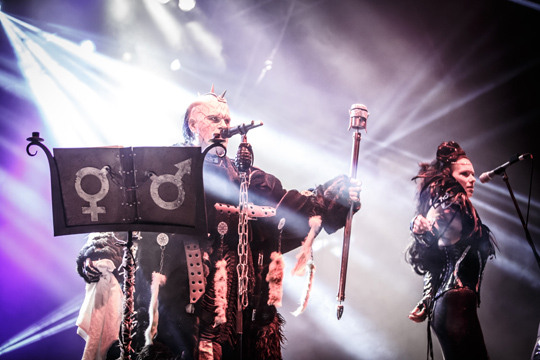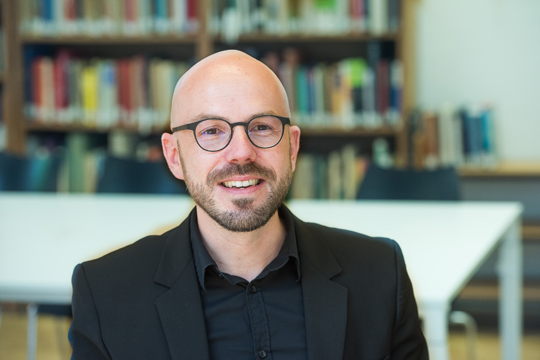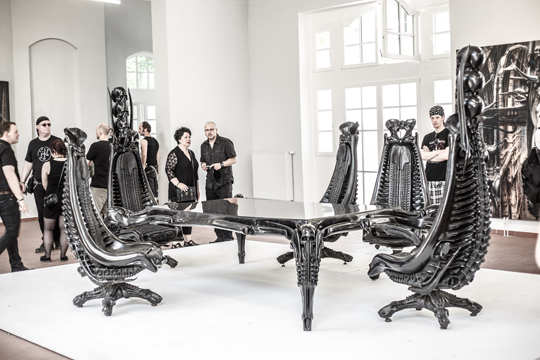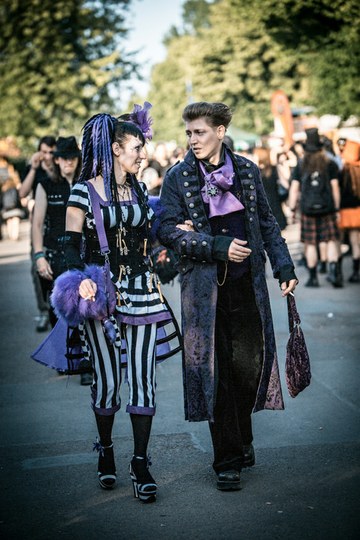Off to a Gothic church service
Freiburg, Aug 24, 2017
Sounds of screeching guitars are wafting over the city. Men and women in black leather and delicate lace are bustling along the streets. They go from stage to stage, thereby leaving looks of amazement on the residents’ faces: more than 20,000 visitors from around the world gather for the annual Goth meet-up called Wave-Gotik-Treffen in Leipzig every year. Among them was Freiburg’s cultural anthropologist Prof. Dr. Markus Tauschek. In his project “Doing Popular Culture: On Performative Design of the Gothic Scene”, he seeks to discover the significance of such festivals for the scene and what happens during them. To support his work, he is conducting field research at three German festivals where he plans on interview scene members. Along with Leipzig, Cologne and Hildesheim are on his travel agenda. Sonja Seidel sat down for a chat with the cultural anthropologist to discover what constitutes the Gothic scene and why people feel drawn to it.

A spiked crown and scepter: a concert at the Wake-Gotik-Festival in Leipzig. Photo: Marina Kugelmann
Mr Tauschek, how did you come to research the Gothic scene?
Markus Tauschek: It was totally by accident. Years ago I was in Leipzig and the entire city was filled with people in black, partially wearing quite unusual clothing. I asked myself back then, what on Earth is going on? What I didn’t know was that every year over Pentecost weekend, the world’s largest Gothic festival is held in Leipzig. I did some research on it and starting building contacts within the scene. There are multiple sociological studies on it, but most of them left questions unanswered in my view.
Which?
The studies completely ignore cultural practices. I was interested in learning what actually happens at the festival: how do the people act and what kinds of interactions take place there? I wanted to know how the scene is constituted through the festivals and how it constantly changes. For instance, at the festival in Leipzig, you can witness multiple cultural-industrial offerings. There are exhibits, readings, sales fairs, a Gothic church service, concerts and parties. The whole thing has a sort of folk festival flair to it.

Popular culture reveals a lot about how a society works, says Markus Tauschek. Photo: Klaus Polkowski
How can the scene be characterized?
It is very diverse. There are many sub-groups such as the neoromantics or the steam punks who have a different style of clothing and music taste. A certain type of difference management exists: “We are the right scene members, the others don’t belong here.” A common characteristic, however, is their reliance on the color black. There is also a strong emphasis on physicality and a highly confident way with which they deal with their own bodies, including how gender roles are questioned partly through their style of clothing. Other characteristics include their reliance on darkness, mental reflection and speaking about death. But now we’re coming to a point that doesn’t hold true for all Goths. Some use the scene merely as a forum for aesthetic experience.
Does self-portrayal play a significant role then?
Yes, you can see that at the festivals. There are a lot of professional photographers there, a lot of it is about being seen – sometimes it almost seems as if you are on a catwalk. But there is also another side to it: Gothic culture thinks critically about society. What is particularly interesting for our research is the fact that there are two political camps in the scene: a leftist part that is consciously anti-fascist and goes against right-wing thinking, and a part of the scene that listens to extreme-rightist music. These participants meet up during the festival and build a collective for a specific period of time – of course, there are also conflicts that are only later played out, for instance, on social media. This is the point at which our research gains political relevance.

The festivals provide visitors various cultural-industrial offerings – including fairs during which furniture is sold. Photo: Marina Kugelmann
Based on how this collective behaves, can you make any general statements about society?
I think we can. In popular culture research, to which the Gothics most certainly belong, we are still battling the appearance of not being serious, which has a lot to do with how Germany perceives what is science and what is not. At the same time, popular culture and music are more important than ever today because it significantly shapes people’s everyday lives. Popular culture reveals a lot about how a society works. The way in which people consume says a lot about how they see themselves. Further, you can learn a lot about mass culture and about societal changes in general if you look at smaller societal groups that view themselves as countercultural.
What significance do these festivals have for these societal groups?
Our initial thesis is that festivals have the function of stabilizing the scene and, at the same time, transforming it. The festivals help reassure the members again and again: “We are part of a larger family.” Besides, the festivals help the scene distinguish itself from the outside world. Gothics attract our attention in our everyday lives because they are dressed so differently. They experience being “other”. At the festivals, they are the exact opposite: they have a sense of belonging. What you also shouldn’t forget is the mutual celebration and dancing, the experience to feel your own body and your own self and that for days on end with very little sleep while listening to concerts the whole time. This kind of daily cycle does something to your body.

Purple couple: Members of the diverse Gothic scene share their emphasis on physicality and their love for extravagant clothing styles. Photo: Marina Kugelmann
Why do people turn Gothic?
A lot of the people with whom I have spoken happened upon the scene by accident. Others entered it by questioning society and their own lives. But there are other examples as well: I had a very impressive conversation with a man who became a part of the scene in his mid-60s. It was clearly a platform for him to create his own identity and to live it out. It is also a kind of alternative world to the everyday, which allows people to live out another side of themselves.
Wouldn’t that go against Gothics’ beliefs to become an object of study?
I thought the same thing at first. I was worried it would be difficult to find interviewees. But the exact opposite happened. They were all extremely open. A lot of people contacted me and my staff later, saying: “We met each other at the festival. If you want an interview, call me.” That’s something I had not experienced with other research projects. I think it has a lot to do with many Gothics’ need to correct the image that is often portrayed in the media with the backing they get from research.

